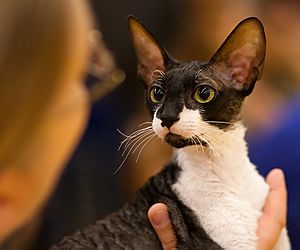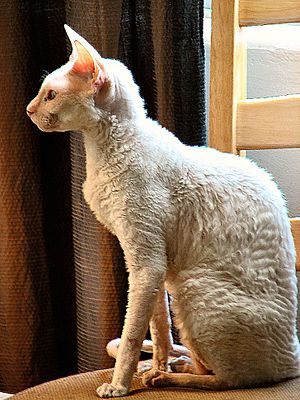Cornish Rex facts for kids
Quick facts for kids Cornish Rex |
|
|---|---|
 |
|
| Origin | United Kingdom |
| Breed standards | |
| CFA | standard |
| FIFe | standard |
| TICA | standard |
| AACE | standard |
| ACF | standard |
| ACFA/CAA | standard |
| CCA-AFC | standard |
| GCCF | standard |
| Domestic cat (Felis catus) | |
The Cornish Rex is a special breed of cat known for its unique, curly fur. Unlike most cats, which have three types of hair, the Cornish Rex only has one type: the soft, wavy undercoat called "down hair." This makes their fur feel incredibly soft, like velvet! This breed first appeared in Cornwall, Great Britain.
Contents
What Makes a Cornish Rex Special?
Their Unique Coat
The fur of a Cornish Rex is very fine and often curly. Because their coat is so light, these cats prefer to live indoors in warm, dry places. They can get cold easily, so they love to snuggle up near warm spots. You might find them near computer monitors, light bulbs, or on your lap or shoulders!
Playful and Smart Personality
Some people call the Cornish Rex the "Greyhound of cats." This is because they look sleek and can run very fast, like a galloping dog! These cats often stay playful and energetic their whole lives, just like kittens. Many Cornish Rexes enjoy playing fetch, racing other pets, or doing amazing acrobatic jumps.
Cornish Rex cats are also very adventurous and super smart. They can easily get used to new places and love to explore every corner. They are very curious and enjoy being around people. They also get along well with other pets.
Many Colors and Patterns
Cornish Rex cats come in a huge variety of colors and patterns. You can find them in solid colors like white, black, chocolate, or orange. They also come in lighter shades like blue, lilac, and cream. Many have tabby patterns, including classic stripes or spots. You might also see them with a bicolor "tuxedo" coat, tortoiseshell patterns, "smoke" colors, or the special color-point pattern seen in Siamese cats.
How They Got Their Curly Hair
A Special Gene
In 2013, scientists discovered what makes the Cornish Rex's fur so curly. They found a tiny change in a gene called LPAR6 on one of their chromosomes. This small change makes the hair shaft different, causing the fur to curl. This gene is important for keeping hair strong and healthy. In humans, similar changes in this gene can also lead to very curly or "woolly" hair.
Where Cornish Rex Cats Come From
A Farm in Cornwall
The first Cornish Rex was born in the 1950s on a farm in Cornwall, UK. One kitten in a litter, a cream-colored male named Kallibunker, had incredibly unusual, fine, and curly fur. He was the very first Cornish Rex!
To keep this unique trait, Kallibunker was bred back to his mother. This produced two more curly-coated kittens. One of these, a male named Poldhu, had a daughter named Lamorna Cove. She was later taken to America and bred with a Siamese cat. This helped give the Cornish Rex its long, thin tail and large ears.
Different from Devon Rex
The Devon Rex cat looks similar to the Cornish Rex, but they are different breeds. The Devon Rex has guard hairs, which the Cornish Rex does not. The genetic change that causes the curly fur is also different in each breed. If you breed a Devon Rex and a Cornish Rex together, their kittens will not have the short, wavy fur. Another cat breed with very little hair is the Sphynx cat, which might have only a very light fuzz.
Are They Good for People with Allergies?
Understanding Cat Allergies
Some people think that because Cornish Rex cats have short hair, they won't cause allergies. However, this is not entirely true. Cat allergies are not caused by hair length. They are caused by a protein called Fel d 1. This protein is found in a cat's skin, saliva, and urine.
When a cat cleans its fur, the saliva dries and turns into tiny dust particles called dander. People who are allergic breathe in this dander. Since Cornish Rex cats groom themselves just as much as other cats, they can still cause allergic reactions. However, many people report that they have fewer or milder reactions to Cornish Rex cats. If you have cat allergies and are thinking about getting a Cornish Rex, it's a good idea to visit a cattery first. This way, you can see how you react to them.
See also
 In Spanish: Cornish rex para niños
In Spanish: Cornish rex para niños


